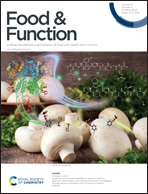Exploring novel Kokumi peptides in Agaricus bisporus: selection, identification, and tasting mechanism investigation through sensory evaluation and computer simulation analysis†
Abstract
Agaricus bisporus contains amino acids associated with thickness and full-mouthfeel, making it a potential candidate for salt substitutes and flavor enhancers in various food applications. Kokumi peptides were isolated from the enzymatic digest of Agaricus bisporus using ultrafiltration nanofiltration, gel chromatographic separation, and RP-HPLC, coupled with sensory evaluation. Subsequently, the peptides, EWVPVTK and EYPPLGR, were selected for solid-phase synthesis based on molecular docking. Sensory analysis, including thresholds, time intensity, and dose-configuration relationships, indicated that EWVPVTK and EYPPLGR exhibited odor thresholds of 0.6021 mmol L−1 and 2.332 mmol L−1 in an aqueous solution. Molecular docking scores correlated with low sensory thresholds, signifying strong taste sensitivities. EWVPVTK, in particular, demonstrated a higher sense of richness at lower concentrations compared to EYPPLGR. Molecular docking and dynamics simulations elucidated that the interactions between Kokumi peptides and the CaSR receptor primarily involved hydrogen bonding, electrostatic interactions, and hydrophobic interactions. Both EWVPVTK and EYPPLGR exhibited stable binding to the CaSR receptor. Active binding sites were identified, with EWVPVTK interacting at Arg 66, Asp 216, Gln 245, and Asn 102, while EYPPLGR engaged with Ser 272, Gln 193, Glu 297, Ala-298, Tyr-2, and Agr-66 in hydrophilic interactions through hydrogen bonds. Notably, these two Kokumi peptides were found to be enriched in umami and sweet amino acids, underscoring their pivotal role in umami perception. This study not only identifies novel Kokumi peptides from Agaricus bisporus but also contributes theoretical foundations and insights for future studies in the realm of Kokumi peptides.

- This article is part of the themed collection: Food & Function HOT Articles 2024


 Please wait while we load your content...
Please wait while we load your content...